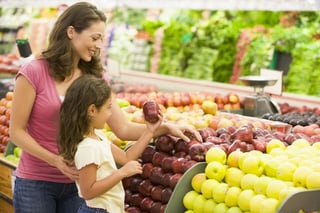Field Trip: Make Grocery Shopping an Exercise in Math
A nickel is heavy; a dollar bill is flimsy. Until you unlock the meaning of the symbolism of these everyday objects, all you see is metal and paper. Taking your budding mathematician grocery shopping can be a great introduction to important math skills.
 Money
Money
The metal and paper that is our currency is very confusing to children. The experts at familyeducation advise slow introductions, beginning with simply identifying money. Not all money is paper, and not all paper is money. Some small metal items are coins, some are tokens, and some are toys.
Preschoolers will not understand the decimal system, of course, but can know that the symbolic dollar can be exchanged for coins that equal the same amount. More dollars can be traded for larger denominations.
Counting
A grocery store is, essentially, a playground for counting skills. Neatly ordered arrays and patterns of canned goods, individual apples, dinner rolls on shelves—all begging to be counted.
For early preschoolers, you could simply ask which has more — our cart or the shelf. For new counters, stop at 10, but older preschoolers should count as high as they can. You will need to listen carefully, because children often count by memory and repeat errors (“nineteen, twenty, eighteen…”) if you do not correct them.
Sizes
The produce aisle can be a great place for math, while still respecting the merchandise (no squeezing!). Hold up a cucumber and a carrot, suggests The Measured Mom, and ask which is longer. Other questions to ask:
- What is the largest vegetable or fruit you can find?
- Do you think you weigh more or less than that watermelon?
Shapes
Reading Rockets' experts say the grocery store is a bonanza of geometric shapes, both flat and three-dimensional. Encourage your child to identify shapes in package designs, containers and displays:
- Is the front of the cereal box a square or a rectangle?
- Are cantaloupes circles or spheres?
Until your child gains confidence, providing either/or questions gives them a 50-50 chance of simply guessing the right answer. Later, make the questions more challenging:
- How many ovals can you find on the box?
- Are the canned vegetables in cylinders, rectangles or spheres?
Grocery shopping can be a learning lab for your budding mathematician. What have you noticed about your child’s math skills during shopping trips? At Kids Konnect, we welcome your ideas, concerns and feedback. Please comment in the space below.
